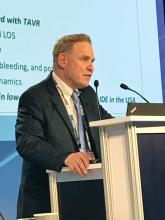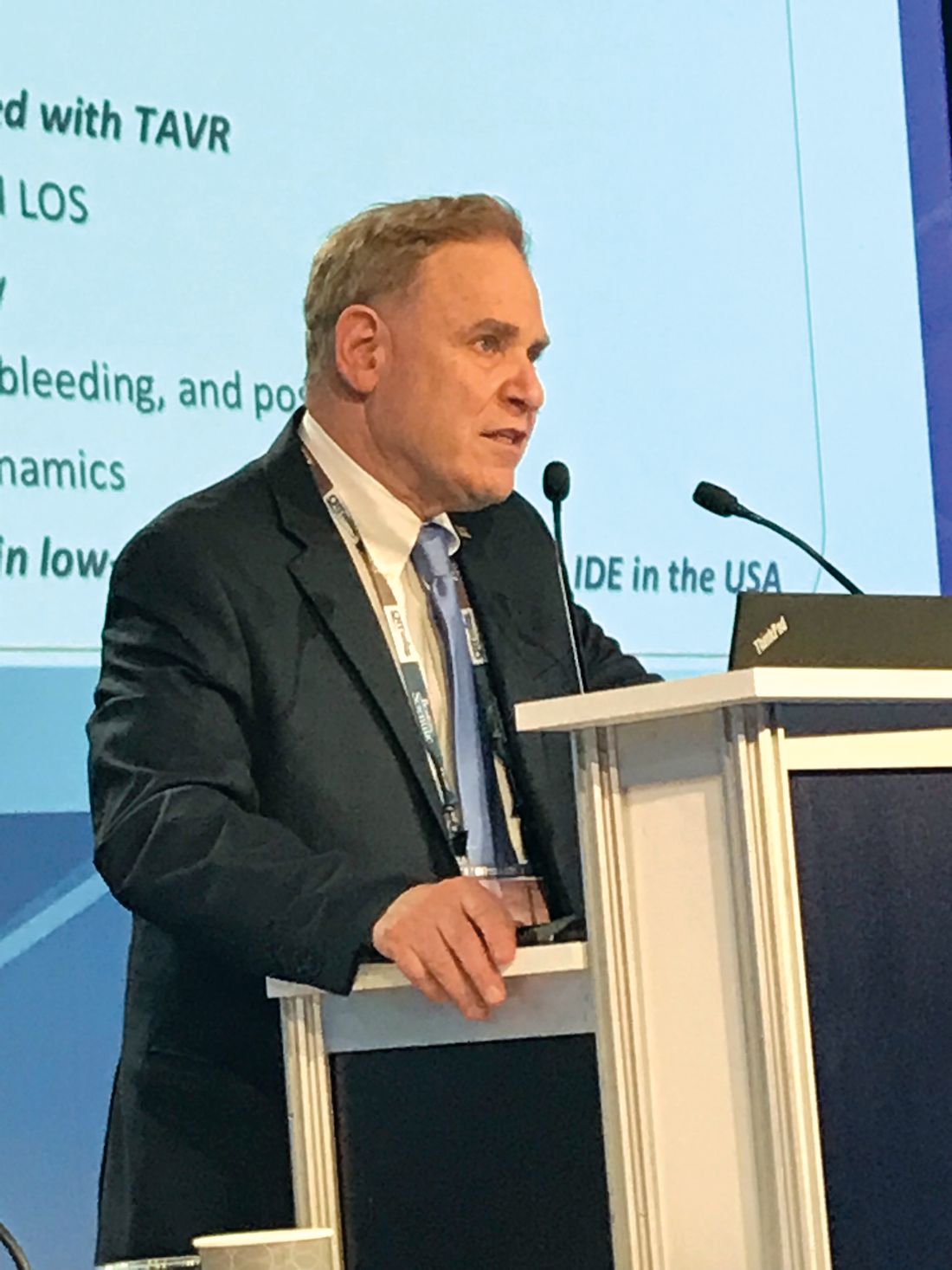User login
WASHINGTON – , according to results of the first U.S. study to evaluate mortality in a low-risk population.
Other complications were also low relative to those seen in previously published studies with higher-risk populations. The preliminary results are “reassuring,” Ronald Waksman, MD, associate director of the division of cardiology, Medstar Health Institute, Washington, DC, reported at CRT 2018 sponsored by the Cardiovascular Research Institute at Washington Hospital Center.
In this study, a low-risk eligibility criterion is a Society of Thoracic Surgeons score of 3% or less. The mean score in the first 125 patients was 1.9%.
At 30 days, there were no myocardial infarctions, no acute kidney injuries of stage II or greater, and no transient ischemic attacks. There was one nondisabling stroke, one paravalvular leak, and one coronary obstruction that required a coronary artery bypass graft. The rates of new onset atrial fibrillation, major vascular complications, and life-threatening or major bleeding events were lower than 5%.
Surgical atrial valve replacement (SAVR) currently has a IB recommendation for the treatment of symptomatic low-risk aortic stenosis, but TAVR is not currently indicated in this population, according to 2017 American Heart Association/American College of Cardiology guidelines. There is, however, substantial interest in extending TAVR to a low-risk population, according to Dr. Waksman.
“We know that there are potential benefits for TAVR versus SAVR that include reduced ICU and hospital length of stay, more rapid quality of life recovery, lower risk of bleeding, and lower risk of postprocedure AF [atrial fibrillation],” said Dr. Waksman in explaining the rationale for this and other ongoing studies testing TAVR in low-risk patients.
In this investigator-initiated study, which was conducted without industry support, 11 sites participated. Most were relatively low-volume centers with fewer than 150 TAVR procedures performed annually, according to Dr. Waksman. The choice of TAVR device was left to the discretion of the operator.
Reflecting a lower-risk population, the mean age of 74.6 years is younger than that of participants in previous TAVR trials. The mean left ventricular ejection fraction was 62.9%. Only 4.8% had a prior MI and 19.2% had a prior coronary artery bypass graft. Most procedures were performed under conscious sedation with fewer than 20% receiving general anesthesia. The mean fluoroscopy time was 16 minutes.
The degree of improvement in hemodynamics following TAVR in this population was called “excellent,” but Dr. Waksman did report a 12.5% incidence of hypo-attenuating leaflet thickening (HALT), an 11% incidence of reduced leaflet motion, and a 9.3% incidence of hypo-attenuation affecting motion. All were subclinical effects.
In a closer analysis of HALT, the rate was 14.4% in the 80.8% of patients who received antiplatelet therapy versus 4.8% in the 17.5% who received oral anticoagulation (some received neither). Dr. Waksman called the greater association of HALT with antiplatelet therapy “a potential signal” that deserves further study.
Full results from all 200 patients are expected in the fall of 2018.
Jeffrey Popma, MD, director of the interventional cardiology clinical service, Beth Israel Deaconess Hospital, Boston, and moderator of the session where the data were presented, called for a direct comparison with SAVR in low-risk patients to place the relative role of these options into context.
Neil Moat, a consultant cardiac surgeon at Royal Brompton & Harefield Hospital, London, agreed. Although he is also encouraged by the evidence of safety in low-risk patients, he labeled the rate of HALT in this study “a concern.”
Dr. Waksman reported financial relationships with Abbott Vascular, Amgen, AstraZeneca, Life Technologies, Med Alliance, Medtronic Vascular, and Symetis, among other companies.
WASHINGTON – , according to results of the first U.S. study to evaluate mortality in a low-risk population.
Other complications were also low relative to those seen in previously published studies with higher-risk populations. The preliminary results are “reassuring,” Ronald Waksman, MD, associate director of the division of cardiology, Medstar Health Institute, Washington, DC, reported at CRT 2018 sponsored by the Cardiovascular Research Institute at Washington Hospital Center.
In this study, a low-risk eligibility criterion is a Society of Thoracic Surgeons score of 3% or less. The mean score in the first 125 patients was 1.9%.
At 30 days, there were no myocardial infarctions, no acute kidney injuries of stage II or greater, and no transient ischemic attacks. There was one nondisabling stroke, one paravalvular leak, and one coronary obstruction that required a coronary artery bypass graft. The rates of new onset atrial fibrillation, major vascular complications, and life-threatening or major bleeding events were lower than 5%.
Surgical atrial valve replacement (SAVR) currently has a IB recommendation for the treatment of symptomatic low-risk aortic stenosis, but TAVR is not currently indicated in this population, according to 2017 American Heart Association/American College of Cardiology guidelines. There is, however, substantial interest in extending TAVR to a low-risk population, according to Dr. Waksman.
“We know that there are potential benefits for TAVR versus SAVR that include reduced ICU and hospital length of stay, more rapid quality of life recovery, lower risk of bleeding, and lower risk of postprocedure AF [atrial fibrillation],” said Dr. Waksman in explaining the rationale for this and other ongoing studies testing TAVR in low-risk patients.
In this investigator-initiated study, which was conducted without industry support, 11 sites participated. Most were relatively low-volume centers with fewer than 150 TAVR procedures performed annually, according to Dr. Waksman. The choice of TAVR device was left to the discretion of the operator.
Reflecting a lower-risk population, the mean age of 74.6 years is younger than that of participants in previous TAVR trials. The mean left ventricular ejection fraction was 62.9%. Only 4.8% had a prior MI and 19.2% had a prior coronary artery bypass graft. Most procedures were performed under conscious sedation with fewer than 20% receiving general anesthesia. The mean fluoroscopy time was 16 minutes.
The degree of improvement in hemodynamics following TAVR in this population was called “excellent,” but Dr. Waksman did report a 12.5% incidence of hypo-attenuating leaflet thickening (HALT), an 11% incidence of reduced leaflet motion, and a 9.3% incidence of hypo-attenuation affecting motion. All were subclinical effects.
In a closer analysis of HALT, the rate was 14.4% in the 80.8% of patients who received antiplatelet therapy versus 4.8% in the 17.5% who received oral anticoagulation (some received neither). Dr. Waksman called the greater association of HALT with antiplatelet therapy “a potential signal” that deserves further study.
Full results from all 200 patients are expected in the fall of 2018.
Jeffrey Popma, MD, director of the interventional cardiology clinical service, Beth Israel Deaconess Hospital, Boston, and moderator of the session where the data were presented, called for a direct comparison with SAVR in low-risk patients to place the relative role of these options into context.
Neil Moat, a consultant cardiac surgeon at Royal Brompton & Harefield Hospital, London, agreed. Although he is also encouraged by the evidence of safety in low-risk patients, he labeled the rate of HALT in this study “a concern.”
Dr. Waksman reported financial relationships with Abbott Vascular, Amgen, AstraZeneca, Life Technologies, Med Alliance, Medtronic Vascular, and Symetis, among other companies.
WASHINGTON – , according to results of the first U.S. study to evaluate mortality in a low-risk population.
Other complications were also low relative to those seen in previously published studies with higher-risk populations. The preliminary results are “reassuring,” Ronald Waksman, MD, associate director of the division of cardiology, Medstar Health Institute, Washington, DC, reported at CRT 2018 sponsored by the Cardiovascular Research Institute at Washington Hospital Center.
In this study, a low-risk eligibility criterion is a Society of Thoracic Surgeons score of 3% or less. The mean score in the first 125 patients was 1.9%.
At 30 days, there were no myocardial infarctions, no acute kidney injuries of stage II or greater, and no transient ischemic attacks. There was one nondisabling stroke, one paravalvular leak, and one coronary obstruction that required a coronary artery bypass graft. The rates of new onset atrial fibrillation, major vascular complications, and life-threatening or major bleeding events were lower than 5%.
Surgical atrial valve replacement (SAVR) currently has a IB recommendation for the treatment of symptomatic low-risk aortic stenosis, but TAVR is not currently indicated in this population, according to 2017 American Heart Association/American College of Cardiology guidelines. There is, however, substantial interest in extending TAVR to a low-risk population, according to Dr. Waksman.
“We know that there are potential benefits for TAVR versus SAVR that include reduced ICU and hospital length of stay, more rapid quality of life recovery, lower risk of bleeding, and lower risk of postprocedure AF [atrial fibrillation],” said Dr. Waksman in explaining the rationale for this and other ongoing studies testing TAVR in low-risk patients.
In this investigator-initiated study, which was conducted without industry support, 11 sites participated. Most were relatively low-volume centers with fewer than 150 TAVR procedures performed annually, according to Dr. Waksman. The choice of TAVR device was left to the discretion of the operator.
Reflecting a lower-risk population, the mean age of 74.6 years is younger than that of participants in previous TAVR trials. The mean left ventricular ejection fraction was 62.9%. Only 4.8% had a prior MI and 19.2% had a prior coronary artery bypass graft. Most procedures were performed under conscious sedation with fewer than 20% receiving general anesthesia. The mean fluoroscopy time was 16 minutes.
The degree of improvement in hemodynamics following TAVR in this population was called “excellent,” but Dr. Waksman did report a 12.5% incidence of hypo-attenuating leaflet thickening (HALT), an 11% incidence of reduced leaflet motion, and a 9.3% incidence of hypo-attenuation affecting motion. All were subclinical effects.
In a closer analysis of HALT, the rate was 14.4% in the 80.8% of patients who received antiplatelet therapy versus 4.8% in the 17.5% who received oral anticoagulation (some received neither). Dr. Waksman called the greater association of HALT with antiplatelet therapy “a potential signal” that deserves further study.
Full results from all 200 patients are expected in the fall of 2018.
Jeffrey Popma, MD, director of the interventional cardiology clinical service, Beth Israel Deaconess Hospital, Boston, and moderator of the session where the data were presented, called for a direct comparison with SAVR in low-risk patients to place the relative role of these options into context.
Neil Moat, a consultant cardiac surgeon at Royal Brompton & Harefield Hospital, London, agreed. Although he is also encouraged by the evidence of safety in low-risk patients, he labeled the rate of HALT in this study “a concern.”
Dr. Waksman reported financial relationships with Abbott Vascular, Amgen, AstraZeneca, Life Technologies, Med Alliance, Medtronic Vascular, and Symetis, among other companies.
REPORTING FROM CRT 2018
Key clinical point: In an interim analysis, transcatheter aortic valve replacement was found safe in low-risk patients with symptomatic aortic stenosis.
Major finding: Through 30 days of follow-up, the mortality rate was 0% or lower than observed in studies conducted in higher-risk populations.
Study details: Interim analysis of 125 patients in a prospective registry study.
Disclosures: Dr. Waksman reported financial relationships with Abbott Vascular, Amgen, AstraZeneca, Life Technologies, Med Alliance, Medtronic Vascular, and Symetis, among other companies.

